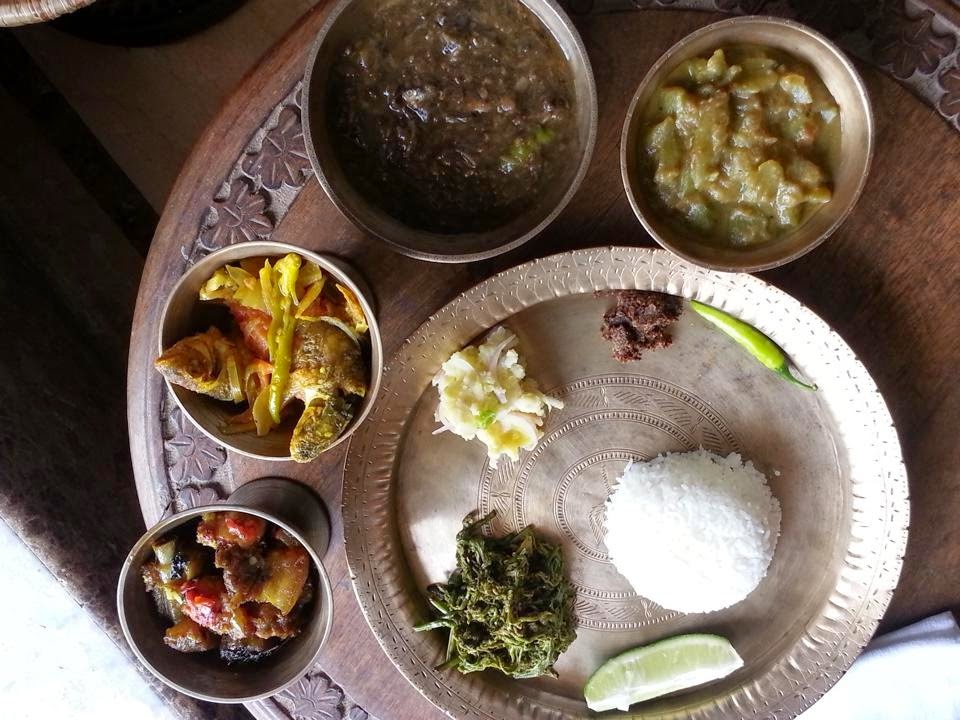A Rustic Assamese Meal
Today I had one of my most memorable meals.When I go to a restaurant,I usually pick the most unusual item on the menu.The lunch today was rustic Assamese made by Gitika Saikia who has lived in Mumbai for 16 years.Except for the Brinjal Pokora(Assamese fritters) which were like Bengali Bejun Bhaja,the rest I had never seen before.My kind of happiness :) .
I was expecting it to be like Bengali food but it wasn't.Assamese food too varies with the season.
Mumbai has no Assamese restaurant but Bengaluru does.
I first read about Assamese food in Charmaine O'Brien's Penguin Food Guide to India which explains cuisine of every state
The pop-up organized by the Small Fry Company's division called "The Secret Ingredient"was at a store at Khar.It is run by Insia Lacewala and Paresh Chabbria.They want people to experience secret ingredients of various regional cuisines that can only be found in home meals
We were seated around a low table around cushions."Like Snow-white and the seven dwarves " said my friend Benaifar.
We were eating with our hands hence my pictures aren't good as I was trying to click with my left hand,an art as you can see, I have yet to master :)
There is no bread in Assamese cuisine (and in Saraswat cuisine too) We were served rice (Basmati but sticky rice Joha is eaten in Assam) wrapped in haldi leaves.With it came Lau Khar,made of pulses and bottle gourd.Lest you think it tasted like dal,it had a base made from water passed through ashes of burnt banana tree roots.It lent an distinct earthiness and is known to aid digestion.You can see the process of making it here,wherein Gitika featured on The Foodie on Times Now with Kunal Vijayakar.
We were served Bhoot Jholokia Pickle,the spiciest thing I have ever tasted in my life! Enough to send you through the roof, if you have too much.The lime they use is called Kaji Nemu and a slice is fragrant enough to make a jug of lemonade
My friends (Pradeep,Kiran and Supriya) liked the Fermented Bamboo Shoot Mash.It was much too strong for me.For some reason it reminded me of horses.Even the Saraswat community makes this.Bamboo Shoot is only available in June-July.It is then stored with salt and stays for months.In Karnataka and Assam,there is hilly terrain and heavy rain which explains bamboo shoot being common to both cultures,my friend Pradeep explained.
The vegetarian items bowled us over.Pumpkin Leaves stir fried in mustard oil,Koldil Pitika (Banana Flower in black sesame paste) and Posola Bhoji (Banana Stem with black chana).Liked them so much that I did not attempt abandoning them to taste the pork served on my plate....and that's saying a lot
The nonveg items were Katla fish cooked with sesame seeds (Til Aru Mas) which was a black curry and Khorisa Gahori which had both fresh and smoked pork along with bamboo shoot.The pork had been smoked in Gitika's inlaws' kitchen,hanging above their chullah for months
We bit into black organic jaggery and then sipped black Assamese Tea and chatted about bygone days......the good life....
Pickling is a part of Assamese cuisine.Fermentation too.Michael Pollan's book "Cooked" has an excellent chapter on fermentation in various cultures and how it not only extends shelf life but also adds to nutritional value.
We were given gifts of miniature traditional farmer hats :) Very sweet of Gitika!













Comments
And I also love the fact I seem to creep in to your blog :D
Most of the pipcs have come out really nice.
Hope to see ya soon! xoxo
I watched the video of the making of the daal with papaya using this water - I think the color change comes from the reaction of haldi with the water, which must be slightly acidic. Normally the yellow pigment of haldi is from the curcuminoid phenols, but these can react with acid, allowing the redder carotene pigment to dominate. Fresh turmeric root is redder in color than haldi powder. One can see reversible color changes by using washing liquids with turmeric - yellow to red - and reverse that with some vinegar.